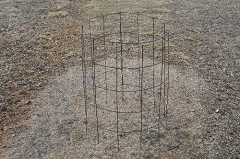
Count off 13 squares but cut each horizontal wire at the end of the 13th square. This will leave a series of 12 complete squares horizontally with prongs left on the 13th square. Use these prongs to make a cylinder by bending the prongs over the vertical wire on the first square. Cages using this method will be about 2 feet in diameter. Tomatoes with large, rangy vines need all five feet of the mesh, but those with shorter, semi-determinate vines can get by with a shorter cage.
Also, cut off the bottom horizontal wire to leave prongs that can be pushed into the ground to help with stability. In windy locations, a T-post will likely need to be driven near the cage. Tying the cage to the T-post can help prevent the cage from toppling in windy conditions.
These cages will last for years, but do take up a great deal of storage space when not in use. (Ward Upham)
 RSS Feed
RSS Feed
